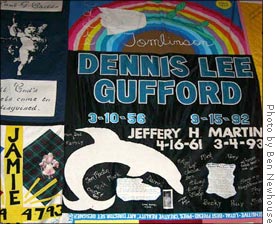| << Front page | News | March 12, 2004 |
AIDS victims commemorated
 |
||
| Memories: AIDS victims are remembered on a quilt in Wilder. | ||
Twelve sections of the AIDS Memorial Quilt are on display this week in Wilder Main.
The Quilt features 3-by-6-foot panels, each memorializing someone who has died from AIDS. The panels are as diverse as the people they represent, but they all convey the tragedy experienced by those who lose loved ones to AIDS. All of the panels on display in Wilder this week commemorate people from the Ohio area. One of the quilt’s most powerful features is its personifications of the AIDS epidemic, putting faces and names to numbers.
“I think the story of AIDS is really a story of denial,” Dr. Mike O’Hara, who spoke at the opening ceremony Monday said. “This quilt was made to answer that.”
O’Hara spoke about the many levels on which this denial operates: governments refusing to admit that AIDS is a problem, families distancing infected loved ones and individuals denying that infection is a real risk. Treating AIDS patients gave O’Hara first-hand experience to the ways in which they are sometimes marginalized within society as well as within their own families.
“I had patients dying and signing their houses over to me because there was nobody else to give it to,” O’Hara said. He also noted that medical professionals aren’t immune from denying AIDS patients full visibility and humanity, and said of himself, “I wasn’t treating patients, I was treating diseases.”
The Quilt gives life and visibility to people lost to AIDS by confronting viewers with individual renderings. Each panel is distinctive: the leather jacket and “HOLCER” vanity plate stitched onto Alan Holcer’s, the Mario and Teenage Mutant Ninja Turtle figures on M.J. Newport’s, who died at age eight. Many panels contextualize the person they represent with memories and messages of family members and friends. Dennis McDermott’s panel bears this message from his father: “I loved you too late, but I did love you. Dad.” Viewing these panels makes real the lives of those claimed by AIDS and the suffering of those they left behind.
Micah Peterson read names at one of the Quilt viewings.
“It’s a mixed feeling where you may even want to cry, but you may not know why you’re crying,” Peterson said. “There’s a presence in the room but you can’t pinpoint where it’s coming from. It’s a feeling.”
The Quilt began in 1987 with the creation of the NAMES Project Foundation. When it was displayed in Washington, D.C. in October of that year, it contained 1,920 panels and filled a space larger than a football field. When it was last displayed in 1996, it included over 40,000 panels and covered a space larger than 24 football fields. Since its creation, more than 12.5 million people have visited the Quilt. It was nominated for a Nobel Peace Prize in 1989, and is described by the NAMES Project Foundation as “the largest example of a community art project in the world.” Through displays of the Quilt, the Foundation has raised nearly $1.85 million for AIDS service organizations.
Student HIV educators Sophia Cosmadopoulos and Lucy Trask brought the Quilt to campus. Trask said AIDS awareness events in the past, such as the AIDS Walk, hadn’t been as well-attended as they would have liked. They hope the quilt, which they feel appeals to a more creative audience, will generate a lot of on-campus interest.
The Quilt is open for viewing until Friday from 3-5 p.m. and from 7-9 p.m. in Wilder Main.
About us
Subscriptions
Advertising
|